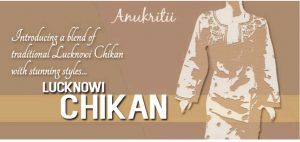
Timeless, Classic – that’s chikan embroidery of Lucknow! Chikan Work in Indian Fashion arena has come a long way. This living craft tradition has seen vicissitudes but remains rooted in the city of origin. Various designers have transformed chikan into ethnic dress so much so that, chikan work and fabric, traditionally a summer collection has become a winter couture as well. Chikan work is no more confined to traditional Salwaar Kameez, Kurta Pajama and Sarees, but is a delight to wear and watch in almost all kinds of western wear like funky tops, designer kurtas, enticing skirts, etc.
The Innovations and Experimentations in Chikan Work The color selection for chikan has undergone a change tremendously. Out went the voiles and mulmuls and the pastel shades and came georgettes, tussars and silk that exhibit the Chikan Work in symphony with the traditional and western designs and styles. It’s not just chikan work on fabrics like cotton, but experimentation, the order of the day, has enhanced basic chikan with more detailing- with zardozi, crystals and so on.
The refinement of taste The various occasions on which chikan work forms the usual code has witnessed lot of changes. Now chikan is no more a casual wear but is also found in a wide variety of formal wears. Be it any kind of gathering amongst the ‘young’ & ‘restless’ and chikan is the most selective style. Now that chikan has a designer stamp and has lit up the lamp, it is been increasingly seen on college campuses and in offices too. Bright fruity color with white embroidery over singlets are very popular with collegians. Chikan work is also showcased in item that enhances your home décor. Items like tablecloth, napkins are beautified gorgeously with the use of chikan work..
Stages involved in making process are:
- Block printing
- Embroidery work
- Washing
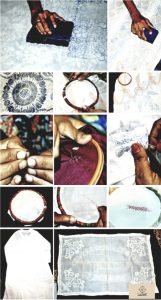
Block Printing: Initially, the design to be worked is printed on the plain fabric. The wooden block is dipped in the color solution which is made by mixing glue and indigo. Then it is printed on the fabric. There will be different blocks for butis, floral patterns and borders. In Lucknow, the printing process is done by separate group of artisans who mainly concentrate in printing. The printed fabric is now ready for the embroidery work.
Embroidery work: The embroidery is done over the printed design pattern using needle and thread. The artisan creates traditional patterns using different techniques. Different types of stitches can be made in one product.

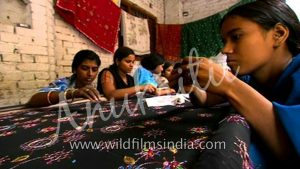
Washing: Washing is the final stage of production process. The fabric after embroidery work is first soaked in water and then washed to remove the block printed blue color. Then it is starched and ironed to obtain stiffness. The final product is now ready for the market.
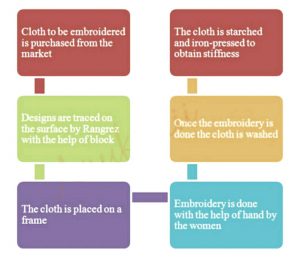
Tepchi work sarees is most delicate work as it uses a very thin thread .Tepchi work speciality is that the difference between the right and the wrong side cannot be made out by just looking at it hence called as magic work. Each stitch is symmetric to the other. Marvellously hand embroidered tepchi work gives a decent and stylish look to the Saree.
Tepchi work is done on designer sarees which is finely and neatly hand embroidered with traditional whiter threads on Pallu and Border. It enhances the beauty and elegance of a woman
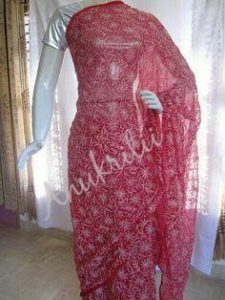
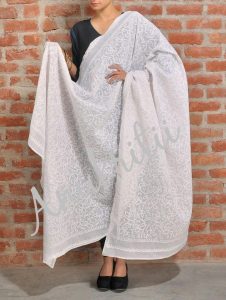


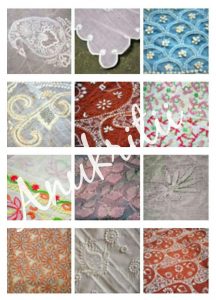
Lucknow- the state capital of Uttar Pradesh is world renowned for its traditional Chikankari Embroidery. Chikankari is the embroidery work done with the white cotton thread on fine white cotton material. The word ‘Chikan’ is basically derived from Persian word ‘Chikan’. In earlier days, the Chikankari embroidery is traditionally done on mulmul- fine muslin cotton. Due to non-availability of mulmul, now-a-days this work is done on cotton, wool, chiffon, crepe, organde chiffon and silk clothes using contrast colour threads. The origin of Chikankari is initiated by the influence of intricate carving patterns of Mughal architecture during their period. The Chikan work in Lucknow is older than 200 years and later it is patronized by Nawabs. There are 5000 families involved in Chikankari embroidery in and around villages of Lucknow. The artisans belong to local Muslim community. Nearly 90% of Chikankari work is done by women professionally. Delhi, Mumbai are the other centers for Chikankari work.
Chikankari embroidery consists of 40 different types of stiches. Among them, the five basic stiches are Phanda-small circular dot, Jaali, tepchi-the running stich, murri and bakhia- the most common and popular stitch that gives the shadow effect. Dhoom, Gol-Murri, Janjeera, Keel, Kangan-bangle, Dhania Patti, Murri lambi -the murri stitch ends with sharp point, Karan Phool, Karan, Kapkapi, Bijli, Ghas Patti, Rozan, Meharki, Kaj, Phool chameli, Chane ki patti, Balda, Jora, Penchni, Kauri. Sidhaul jaali, Makra, Mandrazi, Bulbul Chashm, Phool Jaali and Tajmahal are the varieties of Jaali work. Hathkati and bank jaali are the straight line jaali works.
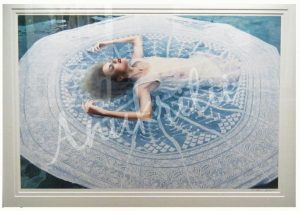
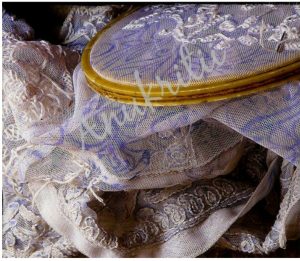
Famous as shadow work, Chikankari embroidery is a very delicate and intricate work from the city of Lucknow. A skill more than 200 years old, the embroidery is famous for its timeless grace and gossamer delicacy. Also known as Chikan, the embroidery is traditionally done using a white untwisted cotton thread on colourless muslin popularly known as tanzeb (the muslim from Dacca).
This form of embroidery came to India from Persia with Noor Jehan, the queen of the Mughal Emperor Jehangir. It is also said that the word chikan is a derivative from the Persian word ‘chikaan‘ meaning drapery. The craft flourished under the benign nawabi influence and later with the British influence designs became more formal resulting in an export market in Europe and England.
Material
Originally, chikan embroidery was done with the untwisted white cotton thread on soft, white cotton fabric like muslin or cambric. It was sometimes done on net to produce a kind of lace. Today chikan work is not only done with coloured threads but on all kinds of fabrics like silk, crepe, georgette, organdie chiffon, and tassar.
Technique
In Chikankari, the design to be embroidered is printed on the fabric using wooden blocks dipped in fugitive colours, which are commonly made by mixing a glue and indigo with water. For extra fine designs, brass-blocks are used sometimes.
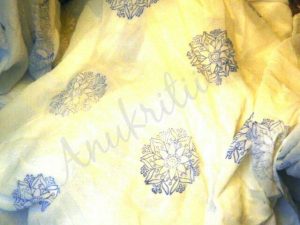
Motifs printed in indigo blue. Once the embroidery is finished the fabric is washed to wash off the blue.
Application of stitches in chikankari holds great importance and demands particular discipline. The embroidery has a repertoire of about 40 stitches which can be broadly divided into 3 heads flat, raised and embossed stitches and the open trellis-like jaali work.
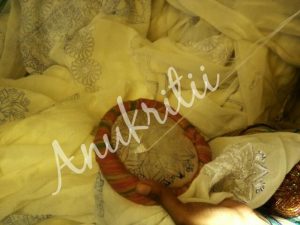
Techinque of Chikankari embroidery
Chikankari flat stitches with their traditional names are:
1. Bukhia: Most common chikan stitch to get the effect of shadow work. Bukhia is very similar to the herringbone stitch done on backside and front side to give a shadow effect.
It is done in two ways
a) From back side (ulta bakhia), the floats lie on the reverse of the fabric underneath the motif. The transparent muslin becomes opaque and provides a beautiful effect of light and shade.
b) From front side (sidha bakhia), it is the satin stitch with criss-crossing of individual threads. The floats of thread lie on the surface of the fabric. This is used to fill the forms and there is no light or shade effect.
2. Taipchi: It is the running stitch worked on the right side of the fabric. It is occasionally done within parallel rows to fill petals and leaves. Sometimes taipchi is used to make the bel buti all over the fabric. This is the simplest chikan stitch and often serves as a basis for further embellishment. It resembles jamdani and is considered the cheapest and the quickest stitch.
Pechni: It is the variation build on Taipchi where the taipchi base is covered by entwining the thread over it in a regular manner thus forming a lever spring.
3.Gitti: A combination of buttonhole and long satin stitch, usually used to make a wheel-like motif with a tiny hole in the center.
4. Jangira: It is the chain stitch usually used as outlines in combination with a line of pechni or thick taipchi.
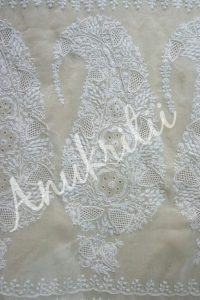
Chikankari knotted, embossed stitches with their traditional names are:
1. Murri: It is the diagonal satin stitches worked several times with a knot on a basic taipchi stitch to form a grain shape.
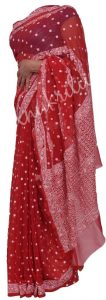
Murri work is the oldest and most sought for form of chikankari. Murri work is a very delicate work done on fabrics such as chiffon , cotton , Georgette, Jute , Kota .
Murri work has stitches as small as the size of a rice grain.It is teamed up with other works such as jaalli, phanda. It complete a full murri work saree it takes about 8-10 months. It takes special expertise and is hence one of the most exclusive and expensive work in chikankari.
Murri work is very rare and most expensive because of decrease in the number of artisans specialized in murri work.
Murri work Georgette saree
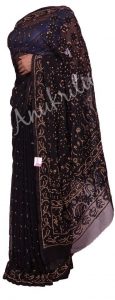
2. Phanda: It is a smaller shortened form of murri. The knots made are spherical and very small. It resembles millets, gives a raised effect and is used to fill petals and leaves.
3. Dhum patti: It is the leaf pattern made of cross-stitch.
4. Ghas patti: It is the grass leaves formed by V-shaped line of stitches worked in a graduated series on the right side of the fabric.
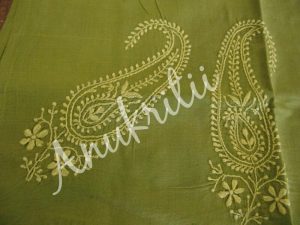
Besides there are two other important forms of embellishments:
1. Jali work: The jaalis or trellises that are created in chikankari are a unique speciality of this craft. It gives an effect of open mesh or net created by carefully pushing warps and wefts apart by needle without cutting or drawing of thread. The act thus make neat regular holes or jaalis on the fabric.
2. Khatawa: It is an appliqué work similar to bakhia, which produces a flat effect. It is more of a technique than a stitch.
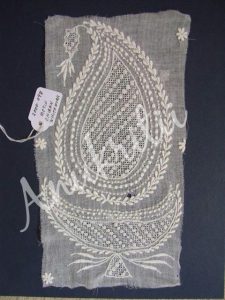
Motifs
The source of most of the design motifs in chikankari is Mughal. Noor Jehan’s personal preferences and desire to replicate the Turkish architectural open-work designs is said to have that led to the introduction of jaalis in chikan embroidery. The designs in chikan are graded and used according to the stitches employed – murri ka buta and tepchi ka jaal – though terms like hathi (elephant) and kairi (mango) are also used to signify the shape of the motif. It is however the stitch employed that is the established nomenclature. Other common motifs include mostly paisley, flowers, foliages, creepers, fruits, birds like peacock and parrots.
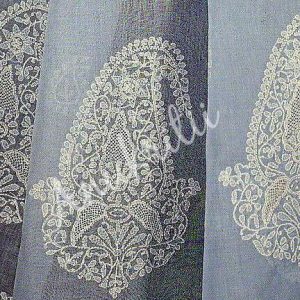
Typical White on White Chikankari
